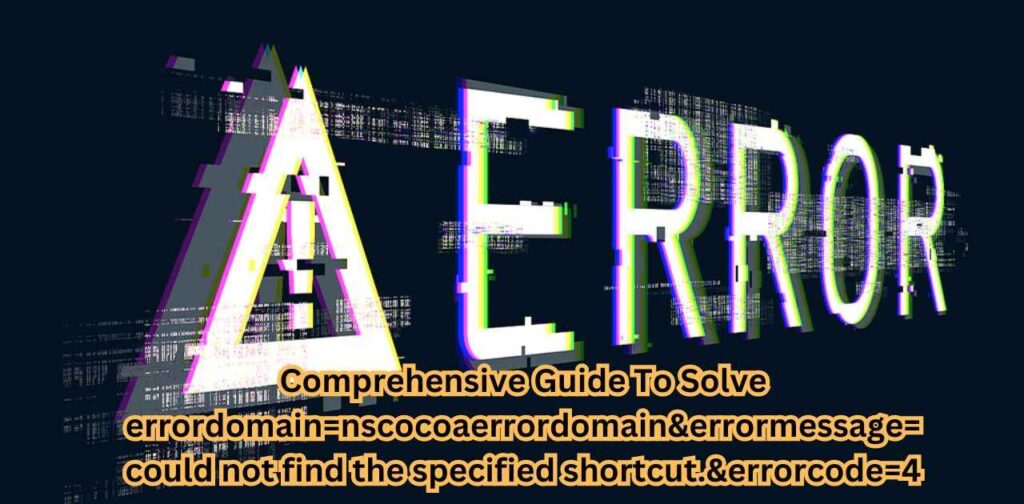The digital landscape is filled with countless error codes, each pointing to specific issues within software applications. One such error that has perplexed many users is within the errordomain=nscocoaerrordomain&errormessage=could not find the specified shortcut.&errorcode=4, where the error message reads: “Could not find the specified shortcut,” accompanied by error code 4. This article delves deep into the intricacies of this error, exploring its origins, implications, and potential solutions.
Introduction to errordomain=nscocoaerrordomain&errormessage=could not find the specified shortcut.&errorcode=4
The errordomain=nscocoaerrordomain&errormessage=could not find the specified shortcut.&errorcode=4 is a collection of error codes used by macOS and iOS applications to describe various issues related to the Cocoa and Cocoa Touch frameworks. These frameworks are the backbone of app development for Apple’s operating systems, providing essential APIs and tools for building robust applications.

The Significance of Error Domains
Error domains categorize errors, making it easier for developers to identify and resolve issues. The errordomain=nscocoaerrordomain&errormessage=could not find the specified shortcut.&errorcode=4 is specifically designed to address errors within the Cocoa frameworks, which are foundational to Apple’s app ecosystem.
Decoding Error Code 4
Within the errordomain=nscocoaerrordomain&errormessage=could not find the specified shortcut.&errorcode=4, error code 4 signifies a problem related to shortcuts. The accompanying message, “Could not find the specified shortcut,” indicates that the system or application could not locate a predefined shortcut, which is crucial for executing a specific function.
Common Triggers for errordomain=nscocoaerrordomain&errormessage=could not find the specified shortcut.&errorcode=4
errordomain=nscocoaerrordomain&errormessage=could not find the specified shortcut.&errorcode=4 can be triggered by various scenarios, such as:
- Missing or corrupted shortcut files
- Incorrectly specified shortcut paths
- Permissions issues preventing access to shortcuts
The Role of Shortcuts in macOS and iOS
Shortcuts in macOS and iOS streamline tasks, allowing users to automate routine activities. They play a critical role in enhancing productivity by reducing the need for manual inputs and actions.
Shortcuts and User Experience
An error related to shortcuts can significantly impact user experience. When shortcuts fail, users are forced to perform tasks manually, which can be time-consuming and frustrating.
Investigating Missing Shortcuts
To resolve errordomain=nscocoaerrordomain&errormessage=could not find the specified shortcut.&errorcode=4, it is essential to determine why the specified shortcut is missing. This involves checking the existence and integrity of shortcut files, as well as ensuring that the paths to these files are correct.
Permissions and Accessibility
Permissions are a common cause of shortcut-related errors. If an application does not have the necessary permissions to access a shortcut, it will trigger errordomain=nscocoaerrordomain&errormessage=could not find the specified shortcut.&errorcode=4. Ensuring proper permissions can often resolve this issue.
Diagnosing Shortcut Path Issues
Incorrectly specified shortcut paths can lead to the system being unable to locate the shortcut. Verifying and correcting these paths in the application’s configuration can mitigate this problem.
Corrupted Shortcut Files
Shortcut files can become corrupted due to various reasons, such as improper shutdowns or disk errors. Repairing or replacing these files can restore the functionality of shortcuts and eliminate error code 4.
The Importance of Backup and Recovery
Regularly backing up shortcut files can prevent data loss and facilitate quick recovery in case of corruption or accidental deletion. This practice is crucial for maintaining seamless app functionality.
Application-Specific Shortcuts
Different applications may have unique shortcuts that are not universally applicable. Understanding the context of the shortcut within the specific application can provide insights into resolving the error.
Developer Insights: Implementing Robust Shortcuts
For developers, implementing robust shortcuts involves ensuring that they are correctly specified, easily accessible, and resilient to common issues such as path changes and permission restrictions.
Testing Shortcuts During Development
Thorough testing of shortcuts during the development phase can help identify potential issues early. This includes testing under various conditions, such as different user permissions and system configurations.
User Documentation and Support
Providing comprehensive documentation and support for users can help them understand how to properly configure and use shortcuts, reducing the likelihood of encountering error code 4.
System Updates and Compatibility
System updates can sometimes affect shortcut functionality. Ensuring that shortcuts are compatible with the latest operating system versions is vital for maintaining their reliability.
Community Forums and User Feedback
User feedback and community forums can be valuable resources for identifying and resolving shortcut-related issues. Sharing solutions and experiences can help others facing similar problems.
Automated Troubleshooting Tools
Automated tools can assist in diagnosing and fixing shortcut issues. These tools can scan for missing or corrupted files, incorrect paths, and permission problems, providing users with a convenient way to address error code 4.
Case Study: Resolving Error Code 4 in a Popular App
Examining a case study of how a popular application addressed error code 4 can provide practical insights. This includes steps taken by developers to identify the root cause and implement effective solutions.
Preventive Measures for Developers
Developers can take preventive measures to minimize the occurrence of shortcut-related errors. This includes adhering to best practices for file management, permissions, and user guidance.
Future Trends in Shortcut Management
The future of shortcut management may see advancements in automation and AI-driven solutions, making it easier to create, manage, and troubleshoot shortcuts.
User Education: Maximizing the Use of Shortcuts
Educating users on the benefits and proper use of shortcuts can enhance their overall experience and productivity. Providing tutorials and tips can empower users to leverage shortcuts effectively.
Exploring Alternative Solutions
In some cases, alternative solutions such as using different automation tools or applications may be necessary. Exploring these options can provide a workaround when resolving error code 4 proves challenging.
Conclusion: Ensuring Smooth Functionality
Ensuring smooth functionality of shortcuts is essential for both developers and users. By understanding the causes and solutions for error code 4, stakeholders can work towards a seamless and efficient user experience.
Resources and Further Reading
For those interested in delving deeper into the topic, numerous resources and further reading materials are available. These include developer documentation, user forums, and technical guides on managing and troubleshooting shortcuts in macOS and iOS.
In summary, error code 4 in the errordomain=nscocoaerrordomain&errormessage=could not find the specified shortcut.&errorcode=4 is a specific issue related to shortcuts within macOS and iOS. By understanding its causes, impacts, and solutions, both developers and users can ensure that shortcuts function correctly, enhancing the overall efficiency and productivity of their applications.
Read More: EXPLORING THE ITE DASHCAM NEXAR – REVOLUTIONIZING ROAD SAFETY AND DRIVING EXPERIENCE






